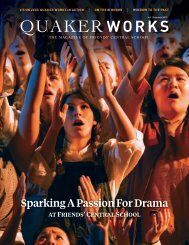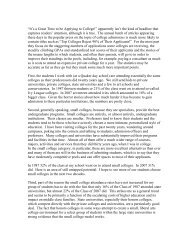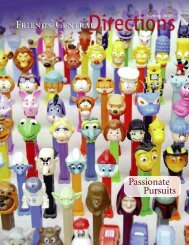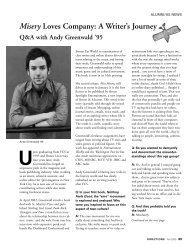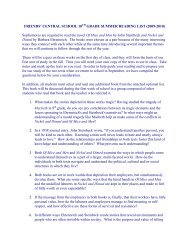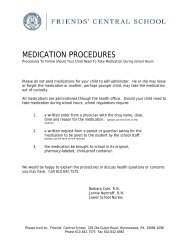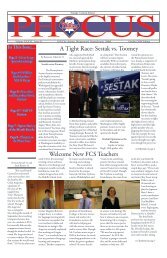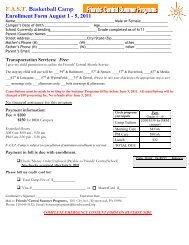2006-2007 Fall/Winter Directions - Friends' Central School
2006-2007 Fall/Winter Directions - Friends' Central School
2006-2007 Fall/Winter Directions - Friends' Central School
Create successful ePaper yourself
Turn your PDF publications into a flip-book with our unique Google optimized e-Paper software.
FEATURES – FORMER FACULTY<br />
Many former Friends’ <strong>Central</strong> faculty members left lasting impressions on the students<br />
they taught here. Floss Jackson and Harvey Zendt are just two whose names still figure<br />
in conversations among alums. Floss reigned over Girls’ Athletics at Friends’ <strong>Central</strong> from 1959 until<br />
1981, and as Connie Lanzl’s ’68 tribute indicates, she profoundly influenced the lives of many of Friends’ <strong>Central</strong>’s<br />
female athletes and students. Harvey Zendt spent a fair amount of time in the athletic building as well, down in the<br />
wrestling room, or “the Bump” as it was more affectionately known. But he also taught science, social studies, language<br />
arts, and surfing during the boisterous period of 1973 to 1988. His energy and enthusiasm for teaching helped<br />
shape the character of the Middle <strong>School</strong> program. Harvey currently serves as Head of <strong>School</strong> at St. Anne's Episcopal<br />
<strong>School</strong> in Deleware.<br />
A Tribute to Floss Jackson<br />
by Connie Lanzl ’68<br />
n September, 1959, in most of the<br />
nation, team sports for young<br />
women were few and far<br />
between. Title IX was still twenty-three<br />
years away from impacting the boundaries<br />
and budgets of every college, university,<br />
and high school in the country. The expectations<br />
for girls in terms of higher education<br />
and career advancement were far less<br />
than for boys. And except for anomalies<br />
like Wilma Rudolph and before her Babe<br />
Didrickson, girls were not only not expected to excel in<br />
athletics, but often discouraged from doing so. The<br />
rationale might have been, of course, that sports were<br />
unladylike, but more to the point, why bother? There<br />
were no rewards, no recognition, and no remuneration.<br />
But Friends’ <strong>Central</strong> in 1959—and long before—held<br />
a different attitude. Team sports for girls were encouraged—even<br />
mandated—because the school believed<br />
strongly in the lessons that could be gained from participating<br />
as a member of a team, regardless of gender: cooperation,<br />
discipline, acceptance of criticism, leadership<br />
skills, strength of character, self-esteem, grace in victory<br />
and defeat, compassion, competition, enduring friendships,<br />
and memories that last a lifetime. It is possible to<br />
gain these experiences in other ways, but team sports contain<br />
them all. And in 1959, Friends’ <strong>Central</strong> clearly<br />
believed they could and should be learned by everyone<br />
from a young age, regardless of innate athletic ability.<br />
September of 1959 was the first month of Floss<br />
Jackson’s twenty-two year career at Friends’<strong>Central</strong>.<br />
That time also coincided with my introduction to field<br />
hockey as a fourth grader. Because I had to wait every day<br />
for my father’s football practice or drama rehearsal to end<br />
32 DIRECTIONS <strong>Fall</strong> <strong>2006</strong> / <strong>Winter</strong> <strong>2007</strong><br />
Terry Cooper and Floss Jackson, 1963



